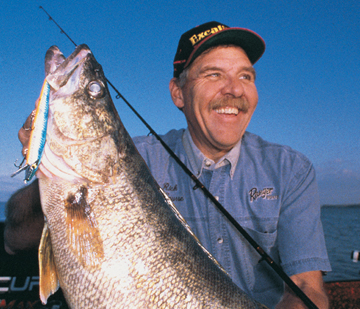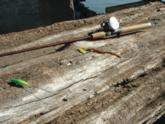Bottom bouncing

Refine your bottom-bouncing skills with walleye tips from Rick LaCourse
How does Ohioan Rick LaCourse maintain a cool head under intense tournament pressure? Experience. It’s hard to fluster a tested veteran. Before he embarked on the walleye tournament trail in 1995, LaCourse made a living for 22 years as an esteemed Lake Erie guide. It was on this vast walleye mecca that LaCourse began dragging spinner rigs behind bottom bouncers on dead rods placed in holders.
As LaCourse’s 30-foot cruiser drifted over Erie’s expansive reefs, the spinners danced behind the bouncers while he and six clients cast weight-forward spinners. Whenever one of the dead rods bowed and bucked, whoever nabbed it first got to land the walleye. On many occasions, the dead rods produced the bulk of the catch.
“A lot of people who hire a charter have little or no fishing skill,” LaCourse said. “A bottom bouncer is so easy to use that it’s an ideal way to get novice anglers into walleyes. When walleyes suspend, all you have to do is crank in line until the spinner swims up where the fish are feeding.”
Now that he’s a touring pro, LaCourse relies on bottom bouncing in about half the tournaments he fishes. This tactic has helped him amass more than $300,000 in winnings and 65 top-25 finishes in his walleye-fishing career.
Refinements
LaCourse refined his bottom-bouncing presentations when he switched to a sleek Ranger 620 tournament rig. The electric motor on the bow and a four-stroke 15 horsepower kicker on the transom afford him exacting boat control regardless of the wind. These crucial tools help him hold his own against other top walleye pros and to precisely probe walleye sweet spots with bottom bouncers on inland lakes.
In tournaments, LaCourse drags his bottom bouncers around the contours of humps and points, along drop-offs, next to the deep edges of weed beds and even over the top of submerged vegetation. He especially likes erratic edges that form inside turns and cups where walleyes congregate.
“When I hit a pod of walleyes, I quickly take landmarks, crank up the lines and run my spinners back over them,” LaCourse said. “Bottom bouncing is a high-percentage approach that keeps my baits in front of the fish.”
Bottom bouncers also come through for LaCourse when walleyes scatter along extended breaklines. Even at the pace of 1 mph or slower that he employs with bouncers and spinners, LaCourse quickly covers expansive stretches, which enables him to pick off individual fish.
The primary functions of a bottom bouncer are to avoid snags and hold the spinner above bottom where a walleye may easily see and attack it. Tagging bottom with the bouncer also provides a solid reference point, so you know exactly where the spinner is working. Each time the bottom prong touches down, it imparts a quirky action to the spinner. It’s the kind of thing that provokes trailing walleyes into striking. Should LaCourse find walleyes feeding over the top of submerged vegetation, he lets out just enough line to allow the bottom bouncer to tick the tops of the greenery.
Live rod vs. dead rod
LaCourse usually runs two rods per person when dragging bottom bouncers. Each angler holds a 7-foot Shakespeare medium-light graphite bait-casting rod while keeping an eye on a 9- to 10-foot steelhead rod that rests in a holder. Light rod tips prevent walleyes from feeling too much resistance when they take the bait. The Shakespeare Catera bait-casting reels on all of the rods feature a flipping switch and are filled with 10-pound-test Silver Thread.
“A flipping switch lets me control the reel with one hand,” LaCourse said. “I push the thumb bar to let out line. When I release the thumb bar, the reel kicks back into gear.”
When LaCourse senses a strike through the rod in his hand, he drops the rod tip back toward the walleye, lets the rod load up and then sets the hook. He never sets up until after he feels the weight of the fish.
The dead rods in holders lie horizontal to the water to get the lures farther from the boat and to make the rods easier to read. Ideally, the bouncers should be barely ticking bottom. The limber steelhead rods offer little resistance when a walleye grabs a spinner, so the fish is more inclined to hold on.
“I let a steelhead rod bow all the way over before I yank it from the holder and set the hook,” LaCourse said. “Grab it too fast, and the walleye will sense something is wrong and spit the hook.”
45 degrees, please
The trolling speed and the weight of the bottom bouncer should work in harmony to maintain the line at a 45-degree angle to the water, an objective that sounds deceptively simple. Attaining it requires experience, concentration and common sense, attributes LaCourse has in abundance.
“The first thing I do is run the spinner under the surface next to the boat so I can determine what speed barely keeps the blade turning,” LaCourse said. “That varies depending on the size of the blade. The speed dictates what weight bottom bouncer I use. It could be anywhere from a half ounce to 4 ounces.”
With a 4-foot leader trailing the bottom bouncer, a 45-degree drag angle should keep the spinner running just above bottom. If the spinner continually hangs bottom or snags vegetation, LaCourse shortens it 6 inches at a time until the spinner runs free. He has fished leaders as short as 18 inches. If LaCourse believes walleyes are on a shy bite, he goes with leaders as long as 5 feet, provided snagging isn’t a problem.
“I also use a long leader when I want the spinner to tag bottom,” LaCourse said. “I usually lift and drop the rod, so the bottom bouncer and the spinner regularly touch down. The bottom contact can be a triggering mechanism.”
Any season
In clear and murky water, walleyes are drawn to the spinner’s vibration and to the commotion caused by the bottom bouncer. This holds true in any season.
“I’ve caught walleyes on bouncers and spinners in water temperatures ranging from 38 to 75 degrees,” LaCourse said.
LaCourse finds spinners to be productive under any weather conditions but especially so in rough water, when casting methods are difficult to implement. Wind and waves rock the boat, which imparts a dynamic action to the spinners and makes the bouncer regularly kick bottom.
“I’m convinced that strong waves spur more bites,” LaCourse said.
Spinners and hard baits
 On inland waters, LaCourse opts for spinner rigs that sport a single, small blade, usually a No. 2 or a No. 3. On the open expanses of the Great Lakes, he prefers bigger blades, a size No. 4 up to a No. 7, which he calls “thumpers.”
On inland waters, LaCourse opts for spinner rigs that sport a single, small blade, usually a No. 2 or a No. 3. On the open expanses of the Great Lakes, he prefers bigger blades, a size No. 4 up to a No. 7, which he calls “thumpers.”
“I almost always use an Indiana blade,” LaCourse said. “It spins easily and puts out a lot of flash and vibration.”
Hammered nickel and hammered gold blades account for 95 percent of LaCourse’s walleyes when he drags bouncers and spinners. Experience has taught him that weather has little to do with which of these two colors will be more productive at any given time. He rigs rods with nickel and silver blades and lets the walleyes tell him which they prefer. Whatever color the blade, LaCourse always matches it with enough chartreuse and red beads to prevent the blade from extending past the hook’s eye, where it would interfere with the bite.
LaCourse goes with a single hook when he baits spinners with leeches and double hooks with crawlers. He changes to a three-hook setup when walleyes short-strike crawlers.
“I’m a firm believer in large hooks,” LaCourse said. “I like a thin-wire No. 4 hook. It has a big bite but doesn’t weigh the spinner down.”
Though quick-change plastic clevises offer convenience, most of LaCourse’s spinners sport metal clevises, which allow the blade to spin easier and to continue revolving at slower speeds.
Occasionally, LaCourse throws walleyes a curve by running a small Smithwick Rogue behind a bottom bouncer. He fishes the hard bait just as he does a spinner, except that he sets the hook immediately when a walleye bites.
Shallow bottom bouncing
Bottom bouncers produce walleyes for LaCourse in water as shallow as 2 feet. When fishing thin water, LaCourse’s 10-foot steelhead rods, which extend horizontally from rod holders, provide enough separation between the bottom bouncers and the boat to avoid spooking the walleyes.
Shallow bottom bouncing came through for LaCourse when he fished a walleye tournament on South Dakota’s Lake Sharpe. His basic setup was a 1-ounce bouncer, a 3-foot leader and a spinner rigged with a No. 3 Indiana blade, which he dressed with a crawler. During the event, LaCourse pulled the spinner over bottom in 12 to 18 feet of water. This depth produced the smaller fish that were needed to fill the low end of an 18-inch slot limit.
For the single walleye allowed over 18 inches each day, LaCourse worked a break along a shallow sandbar. Here he kept his boat over 10 feet of water while his long rods pulled the bouncers in 3- to 4-foot depths. The kicker outboard was necessary to maintain adequate boat control in howling 30 to 35 mph winds.
The dual depth pattern held up all three days of the tournament, and LaCourse finished in fifth place. The shallow sandbar yielded walleyes up to 26 inches long.